The budgie is short for budgerigar. It is the most popular pet bird in the world. In fact, data suggest they are the third most popular of all pet species after dogs and cats.
The budgerigar is in the parakeet family, in other words, a small parrot. These little birds are colorful in appearance, very active and playful. They are inexpensive and easy to take care of, and they can mimic human speech.
Budgie parakeets are native to Australia. All the budgies in the wild are green in color. The first captive breeding took place in the 1850s. Selective breeding has resulted in many different colorations we see today. In the wild, they mostly feed on seeds and chew on various plants. Their natural lifespan is about ten years. They live in flocks from a few dozens to tens thousands.
It is relatively easy to take care of budgies, which is one of the reasons why they are so popular. To keep them healthy, some of the basic needs must be met.
Budgie Cage Setup
A basic budgie cage setup should have
1. A proper-sized budgie cage made of strong material with ideal dimensions
2. Food and water cups
3. Mineral blocks and cuttlebone
4. Perches
5. Bird Toys
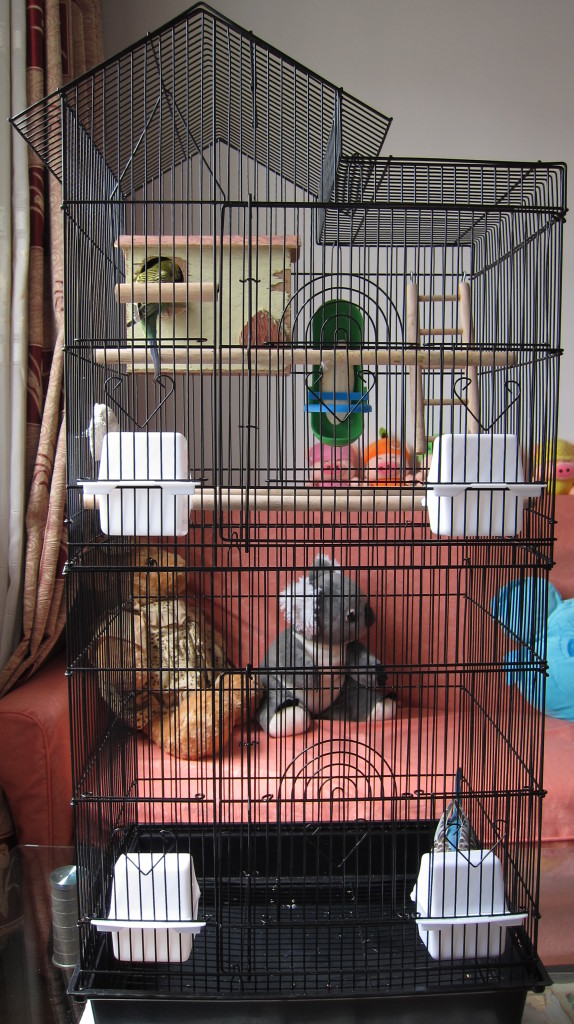
Since budgies are a very active bird species, it is highly recommended to get a birdcage big enough for them to move around freely. A lot of budgie owners suggest huge cages. Some recommend a minimum size of 40 inches (1 meter) long, 20 inches (50 cm) wide, 30 inches (75cm) high. While it is true the bigger, the better when it comes to the cage size, such dimensions are not a must.
The key is to have enough room for the budgies to fly inside the birdcage. So the length and width of a cage should be big enough for their full wingspan at least. If for some reasons, you are unable to get a cage with such length and width, it is entirely fine to get a cage tall enough to compensate for the lack of length and width.
I was once in precisely such situation. The cage I got was about 25 inches x 25 inches x 50 inches tall. I left the food cups near the bottom of the cage, while the perches are near the top. So by having this setting, I forced the birds to fly up and down to get food. It kept them active all day.
Budgie cage should be made of steel if possible. This is from my first-hand experience. My first pair of budgies escaped after they had eventually broken the wooden cage with their strong beaks. A steel cage will make sure they can’t break out of the cage.
The cage’s doors should be secured. On many occasions, I have observed the budgies sliding open the entrance of the cage with their beaks.
Food and Water Cups
At least one food cup is needed, but I prefer two cups. Thus I can always fill up one before the other one is empty.
A single water cup is enough.
Perches
Like in all proper bird cage setup, budgies need at least one perch to stand on. A good setup should have multiple perches set to cross the cage near the top of the cage. They need to be far enough from each other for the budgies to jump between the perches. At least one perch should be higher or lower than the other perches for the birds to jump up and down. Natural tree branches can be good alternatives if they are strong enough for the birds to stand on.
Budgie Food (Diet)
Everyone needs a proper, balanced diet to stay healthy. Budgies are no exception.
In the wild, budgies are opportunistic. While their staple food is grass seeds, they also eat a lot of plants and sometimes insects. In captivity, it is hard to replicate their natural diet. To provide them a balanced diet with all the necessary nutrition, we need to give them as many different foods with all the essential nutrition as possible.
Seeds for Budgie: Not all seeds are suitable for budgies. The key is the size. If they are small enough for the budgies to swallow, or can be chewed into smaller pieces to swallow, then they are budgie foods. Some good choices are quinoa, millet, oat groats, canary seeds, flaxseeds, and buckwheat. It is a good idea always to give them a large variety to ensure they get different nutrients. For example: I have used a seed mix of 30% oats, 20% millet, 20% buckwheat, 10% quinoa, 10% canary seeds, and 10% flaxseeds.
You can use any mix you wish as long as there is a good mix of different seeds. Some commercially available pre-mixed parakeet foods are also good choices if you want to save yourself the trouble to order different seeds from different places. Some of them have packaged dozens of different seeds, nuts, and veggies with fortified vitamins. One of my favorites is Dr Harvey’s Our Best Parakeet Blend Bird Food.
Water: Just give them clean drinkable water. I use filtered, boiled, then cooled tap water. Make sure to wash the water cup and provide fresh water every day.
Veggie: Some of the budgie’s favorites are broccoli and a variety of leafy vegetables. My budgies always go crazy over fresh veggies every time I provide them. To avoid pesticide poisoning, wash the veggies thoroughly if you can’t get organic alternatives. The more varieties, the better.
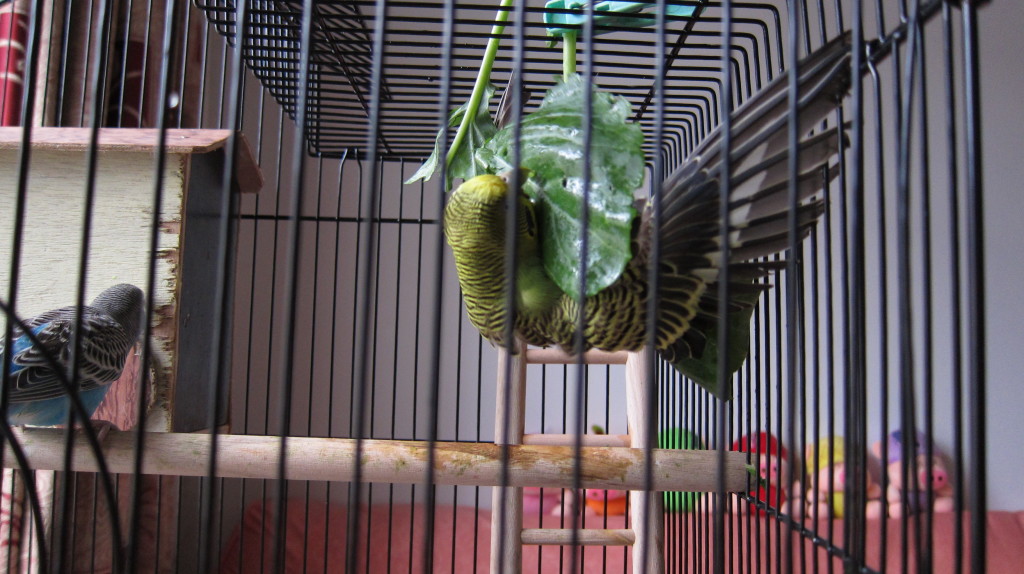
Mineral Rocks: Since we can’t replicate the exact natural diet of the budgies, it is highly recommended to give them supplements to make sure they get enough minerals for optimal health. There are some commercially available mineral blocks for this very purpose. I have used Manu Mineral Blocks with excellent results.
Cuttlebone: Cuttlebone is good for conditioning beak through extra calcium intake and direct trimming. It also acts as a chew toy. A cuttlebone holder is needed to hold the cuttlebone in place.
Budgie Toys
Regular exercise is needed in addition to proper nutrition if you want to stay healthy. Budgies are no different. To get enough exercise, they need plenty of room both inside and outside the cage. Multiple toys are also required for the birds to stay entertained.
Swing toys are one of the favorites for budgies. A little wooden ladder is great too. Some bridges or tree beds are just other examples of what you can get for your birds. Some people suggest rotating different bird toys to avoid boredom. It is not necessary if there are more than just a few toys.
Chew toys are also needed to keep their beaks healthy and strong. Another one of the most popular chew toys is Wesco Pet Kabob Shreddable Bird Toy.
Note: While it is a good calcium supplement, cuttlebone acts as a good chew toy at the same time.
All these items are basics. If you are up for getting more toys for the budgies, go for it by all means. Make sure they are specialized bird toys with no hazardous materials involved. You should also make sure there is still enough room in the cage for the budgies to fly around after installing all the toys.
Budgie Care Details
Like all birds, budgies have a fast metabolism. In other words, they must eat frequently. You need to make sure there is always food in the food cups. By having two food cups, you can achieve this goal more efficiently. You need to clean the water cup every day and refill it with clean, fresh water.
Some people go as far as to sterilize the food and water cups every day. I found it unnecessary since the wild budgies are fine without such strict hygiene practices. Just washing the cups with tap water is good enough. Make sure the seed cups are dry before a refill.
Fresh veggies need to be provided at least every other day, preferably on a daily basis.
Both mineral block and cuttlebone need to be present in a budgie cage at all times.
Although budgies can use some sunlight once in a while, please avoid direct sunlight exposure for an extended period of hot days or hours. It can overheat them and become a potential hazard. It is essential to allow some shade in the cage at all times for the birds to retreat to.
Aside from a balanced diet with varies seeds, veggies, clean water, mineral rock, and cuttlebone, budgies also need plenty of exercise and entertainment to stay healthy both physically and mentally.
Budgies are flock birds. It means they need a lot of socializing, either with other budgies or with you. Getting a male and a female as a pair is ideal. Two males will do fine too. However, multiple female budgies in the same cage are likely to fight. While it might not happen, it is not worth the risk to harm the harmony.
A single male or a single female will do fine. A single male is known for doing better. When there are two or more budgies in the cage, they can socialize with each other and do well on their own. In the case of having a single budgie, you need to spend some time every day to play with him/her.
It does not matter how big the birdcage is; the best exercise should take place outside the cage. I leave the cage open for at least one hour per day for my budgies. They usually come out flying around, and they always return to their cage on their own. Of course, all these activities should take place in a closed room with no hazard nor escape route for the birdies. It serves the purpose of extra workout and entertainment for the birds.
You can also play with the birds directly. The best way to get close to the budgies is to provide them food by hand. They might hesitate at first, once they have tried it once, they will do it again. Eventually, they will get used to feeding on your hand. From that point on, you can go further with them playing and teaching them tricks.
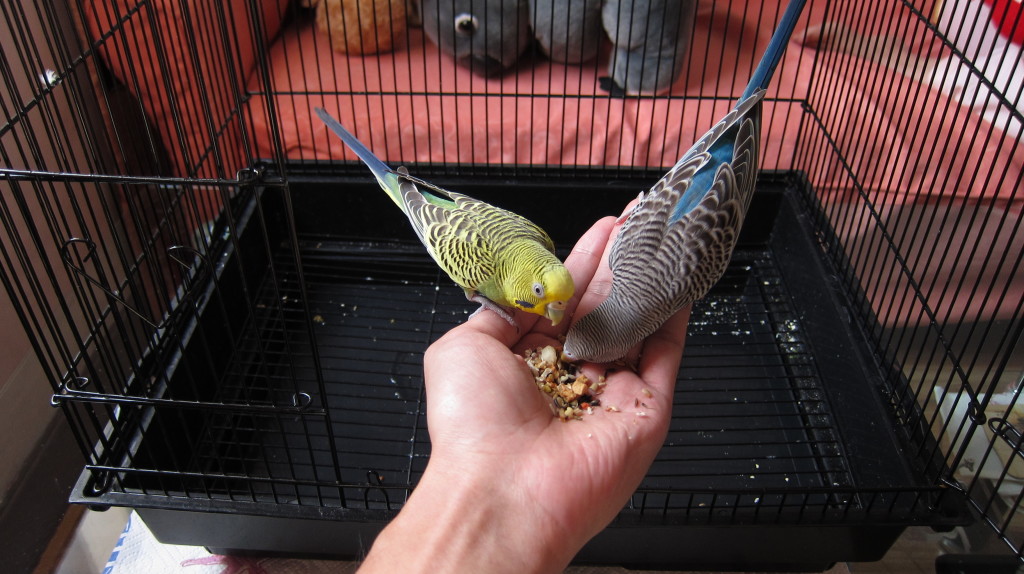
Note: If you wish to teach your budgie to speak, you must be able to get the full attention of the bird first. To get budgie to pay attention to you, there must be only one budgie. When you have more than one, they will most likely ignore you except during the feeding time, and they will just pay attention to each other.
The younger the budgie, the easier it is for the bird to mimic human speech. Male budgies are known to be able to learn a much larger vocabulary than female budgies. Repeating the same word or phrase over and over will eventually get the bird to respond. Patience will pay off. It can take days, weeks or even longer for it to work.
Budgie Hygiene
While budgies can clean themselves in most cases, sometimes they love a good bath. You can provide them a small bowl and fill it with an inch or so clean water. Make sure the water is not too hot or too cold. Some budgies love to go into the water and get wet and clean themselves in the process.
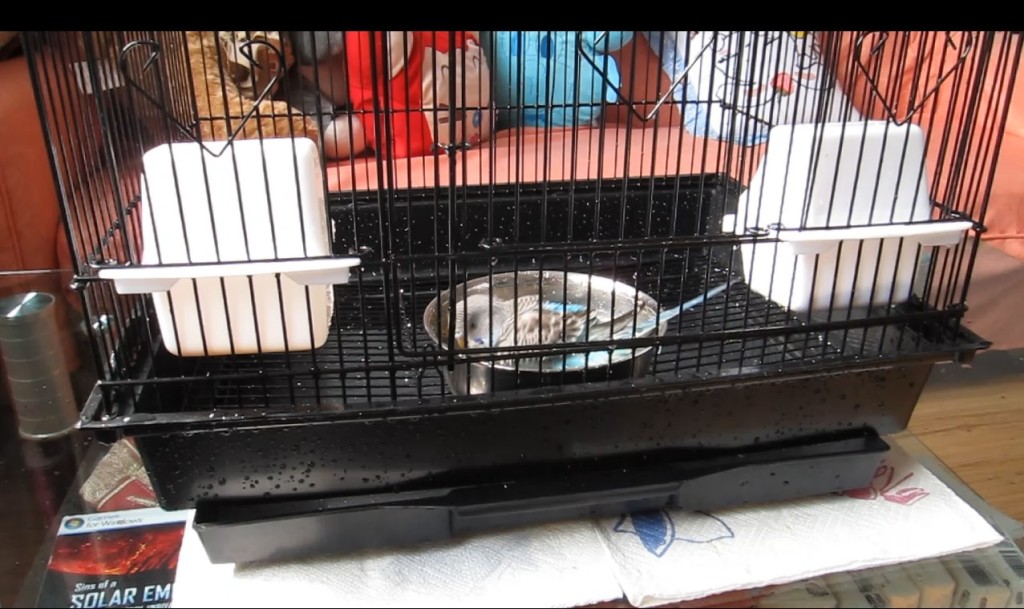
The budgie cage should be cleaned no less than every a few days. You can make the job easier by using old newspapers or magazines to cover up the bottom of the cage. Some cages have a removable bottom slide, which makes the cleaning job a lot smoother.
Budgie Breeding
Identify the Sex of Budgie
You can identify a budgerigar’s sex from the color of cere (nose) above their beak. Before reaching maturity, all budgies show pink on their cere. An adult male will show blue to light purple. An adult female has a white or light brown cere. When in the breeding mood, the female has a dark brown cere.
It is fairly easy to breed budgie in captivity. You only need to provide a pair with a breeding nest, and they will do the rest on their own. There is no need for special conditioning. Nor a need for baby birdie food. The budgie pair will do all as long as there is a birds nest, plenty of food and water, and a safe environment. It is commonly recommended not to breed budgies when they are too young or too old. The general accepted ideal breeding age is around one-year-old to three-year-old if you want a high success rate and healthy chicks.
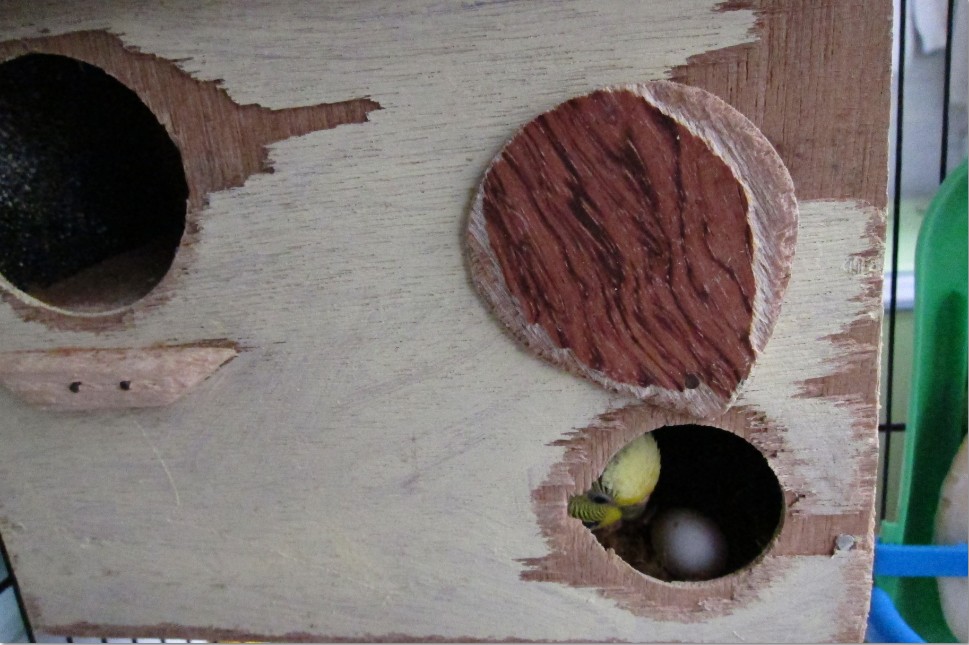
Conclusion on Budgie Care
Overall, Budgerigar is very easy to take care of. They are excellent pet birds for beginners. Under proper care, budgies can live up to 10 or more years in captivity. They also tend to grow larger than their wild counterparts. These beautiful little birds can bring you a lot of joy without costing you an arm or a leg.